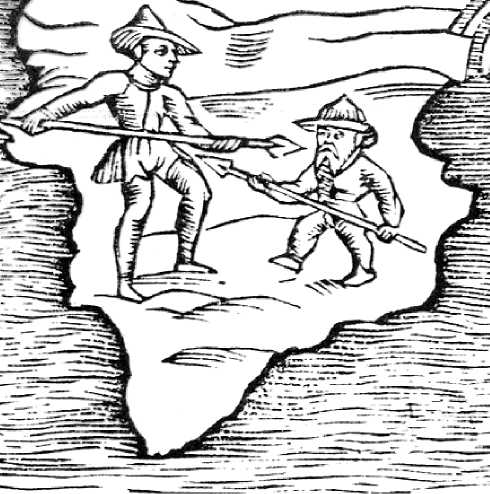In the last decades of the tenth century, Scandinavians settled in two areas on the west coast of Greenland (the so-called Western and Eastern Settlements). With their conversion to Christianity and the foundation of a bishopric at Gardar in the Eastern Settlement during the eleventh century, the Scandinavian settlements joined the periphery of Latin Christendom.
The Scandinavian Greenlanders were aware of the heathen Inuit peoples (whom they called Skraelings) living to the north and west of them, and both Latin sources and the sagas describe contacts in terms of a meeting between Christianity and paganism as well as of conflict; the sagas even relate a few instances of forced conversion. From the middle of the thirteenth century, Greenland became one of the tributary lands of the king of Norway.
The Scandinavian settlements were probably abandoned in the first half of the fifteenth century for various reasons, including climatic changes, but probably not as a result of attacks by heathens, as is sometimes claimed, although the Icelandic annals do tell of one raid by the Inuit resulting in eighteen deaths among the Greenlanders. However, Greenland was not forgotten in Scandinavia, and in the fifteenth century the kings of Denmark maintained their rights to the trade with Greenland, which had become part of their realm on the formation of the Union of Kalmar (1397) uniting Denmark, Norway, and Sweden. They claimed, however, that Greenland had been lost to the heathens, as was reported to Rome in the 1420s, 1448, and 1492. In 1427 the Danish cartographer Claudius Clavus claimed that the heathen Karelians, who lived in Finland, were able to reach Greenland with large armies from the other side of the North Pole via an

European and pygmy fighting on Greenland. Detail from the map Carta Marina, by Olaus Magnus (1539). (Courtesy Janus Moller Jensen)
Unknown land. The idea of a continental connection between Greenland and Europe can be traced back at least to the thirteenth century, and by the fourteenth there was a widespread belief that the Karelians lived north of Greenland.
In the fifteenth century, Greenland came to figure in Danish plans to reach India. From the reign of King Christopher III (1440-1448), Danes participated in the Portuguese crusades in North Africa that, among other goals, aimed to find a passage to India and the mythic realm of Prester John. During the reign of Christian I (1448-1481), Danes continued to participate in the Portuguese crusades, and the king also launched expeditions in cooperation with the Portuguese in order to discover new lands by sailing toward Greenland, and in this context the claims that Greenland had been lost to the heathens were important.
Very little is known of these northern expeditions, but there is no reason to assume that they were conceived as being different in character from the Portuguese crusades to Africa. King Christian II of Denmark (1513-1523) applied to the papacy in 1514 for indulgences for the participants of an expedition that was to go to the islands on the other side of the Arctic Ocean, and in 1519 Pope Leo X issued a bull nominating a new bishop of Gardar because Christian II wanted to “re-conquer the city of Gardar from the hands of the heathens with a mighty fleet” [Diplo-matarium Norvegicum, ed. Christian C. A. Lange et al. (Kris-tiania: Malling, 1902-1913), 17: 1164-1166]. This crusade, which was to be led by the experienced sailor Soren Nordby, was abandoned at the last minute as a result of events in Sweden that eventually led to the dethronement of Christian II in 1523. The latest geographical knowledge at this time (for example, as expressed in the Ruysch world map of 1508) viewed Greenland as a peninsula on the continent of Asia, and from other sources it is evident that India was the ultimate goal of this crusade, as it had probably been for the fifteenth-century expeditions as well.
Contemporaneously with these plans, the legend of a Danish hero was being created that told how in the ninth century India had been conquered by Ogier the Dane, who took possession of all the countries from Jerusalem to Paradise and subsequently founded the realm of Prester John. In a small work (En wdschrifft aff gamble kronnicker...) originating in the court circle of Christian II in 1521, Prester John was counted as one of the three greatest heroes ever to have left Denmark to win great dominion in the world. Such legends were part of a larger ideological program of the fifteenth and early sixteenth centuries that presented the Danish kings as crusading monarchs and must be seen in connection with plans for crusades to Greenland.
-Janus M0ller Jensen
Bibliography
Arneborg, Jette, “The Roman Church in Norse Greenland,” Acta Archaeologica 61 (1990), 142-150.
-, “Contact between Eskimos and Norsemen in
Greenland—a review of the Evidence,” in Beretning fra det tolvte tvxrfaglige vikingesymposium, ed. Else Roesdahl and Preben Meulengracht-Sorensen (Hojbjerg: Hikuin, 1993), pp. 23-35.
Jensen, Janus Moller, “Den glemte periferi og de glemte korstog. Gronland og korstogene, 1400-1536,” Historie 1 (2004), 109-145.
Seaver, Kirsten A., The Frozen Echo: Greenland and the Exploration of North America, ca. a. d. 1000-1500 (Stanford: Stanford University Press, 1996).




 World History
World History









